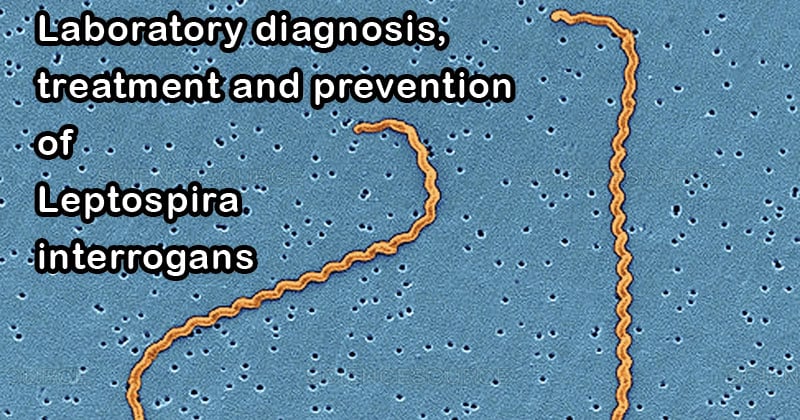Interesting Science Videos
Laboratory diagnosis of Leptospira interrogans
Specimens
- Specimens consist of aseptically collected blood in a heparin tube, CSF, urine, or tissues for microscopic examination and culture.
- Serum is collected for agglutination tests.
Microscopy
- As leptospires are thin, they are at the limit of the resolving power of a light microscope and thus cannot be seen by conventional light microscopy.
- It cannot be detected by Gram stain or silver stain technique.
- Darkfield microscopy is also relatively insensitive, capable of yielding nonspecific findings.
- Fluorescein-conjugated antibodies or other immunohistochemical techniques can be used.

Culture
- Leptospira interrogans can be cultured on specially formulated media (e.g., Fletcher, EMJH [Ellinghausen-McCullough- Johnson-Harris], Stuart’s, or Tween 80-albumin media supplemented with neomycin and 5-fluorouracil.
- They grow slowly (generation time, 6 to 16 hours), requiring incubation at 28° C to 30° C for as long as 4 months; however, most cultures are positive within 2 weeks.
- Growth of the bacteria in culture is detected by darkfield microscopy.
Serology
- The diagnosis of leptospirosis in most cases is confirmed serologically.
- Agglutinating antibodies first appear 5–7 days after infection and develop slowly, reaching a peak at 5–8 weeks.
- IgM antibodies appear early within one week of illness, reach peak levels in third or fourth week and then decline slowly and become undetectable within six month.
- IgG antibodies appear later than IgM, reach peak level after few weeks of illness and may persist at low level for years.
- Various tests available are: Macroscopic slide agglutination test(MAT), Microcapsule agglutination test (MCAT), Latex agglutination rest, ELISA- it detects IgM and IgG separately, Lepto dipstick assay – it detects IgM antibodies, Immunochromarographic test (ICT) – it detects IgM antibodies.
- The microscopic agglutination test (MAT), which can indicate the likely infecting serogroup or serovar, is generally accepted as the ‘gold standard’.
- Several enzyme-linked immunosorbent assay (ELISA) kits offer ease of use together with relatively good sensitivity and specificity.
- Most detect IgM antibodies, which, are detectable in the acute phase of the illness and may remain for several months after infection.
Molecular methods
- PCR has been found particularly useful in severe disease, before seroconversion occurs.
- Various genes such as 16S or 23S rRNA or IS1533 insertion sequence are targeted.
- However, PCR is not serovar-specific and hence, PCR-RFLP (Restriction fragment length polymorphism) or PFGE (Pulsed-field gel electrophoresis) are the methods followed to determine the genome of species of Leptospira.
Treatment of Leptospira interrogans (Leptospirosis)
- Antimicrobial therapy is the mainstay of treatment of leptospirosis.
- Oral doxycycline is the drug of choice for treatment of uncomplicated Leptospira infection.
- Intravenous penicillin or ampicillin is recommended for hospitalized patients.
- Streptomycin, tetracycline, or erythromycin are alternative choice for patients allergic to penicillin.
Prevention and control of Leptospira interrogans (Leptospirosis)
- Prevention of exposure to potentially contaminated water and food helps control the transmission of L. interrogans and reducing contamination by rodent control.
- Measures to reduce rodent populations in the vicinity of human activity, such as removing rubbish, especially waste food, and prevention of the access of rats into buildings is most important.
- Simple measures to reduce the risks of acquiring infection also include covering cuts and abrasions with waterproof plasters and wearing protective footwear before exposure to surface waters.
- Mass immunization of domestic livestock will prevent clinical disease in the animals and reduce the risk of human acquisition of infection.
- Awareness of leptospirosis through the education of doctors, employers and the general public help to develop safer practices or procedures in the workplace and during recreational pursuits.

Good job!